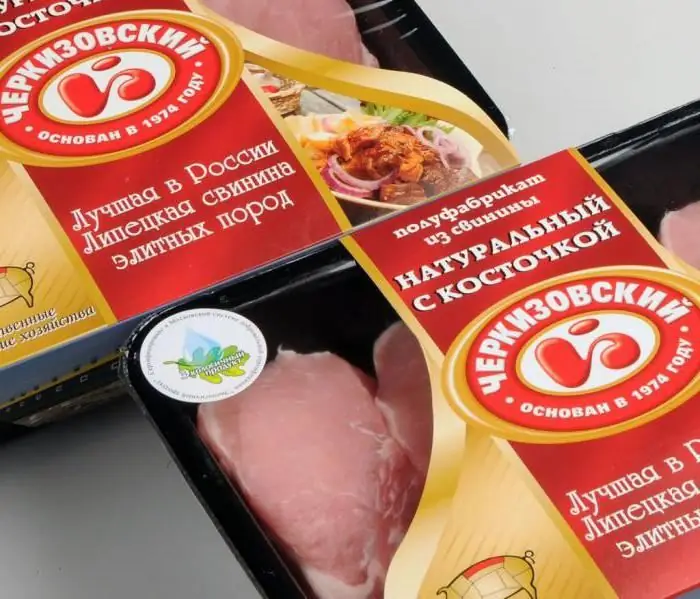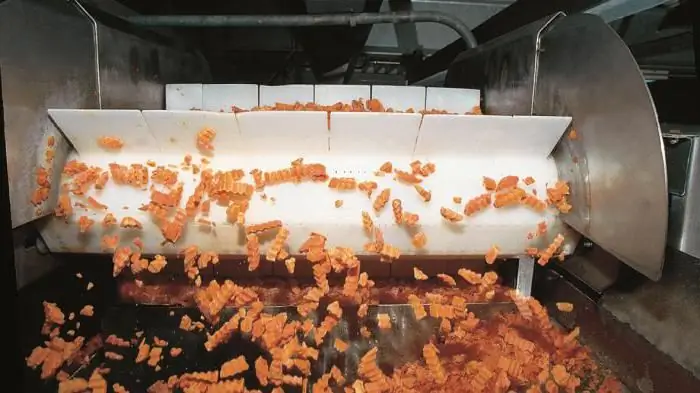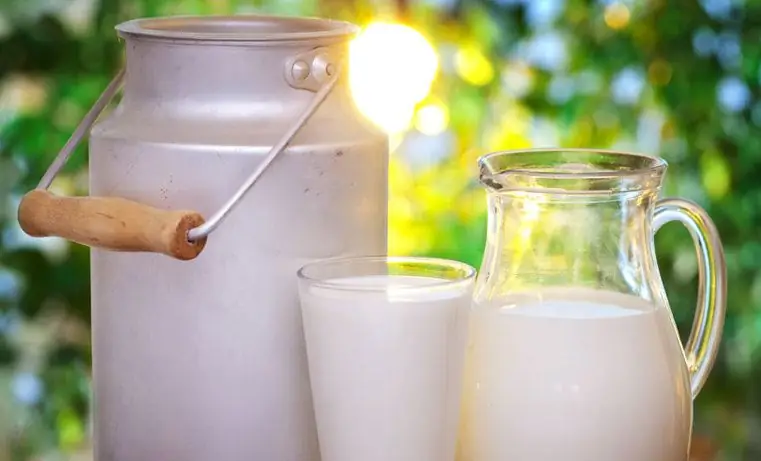2026 Author: Howard Calhoun | [email protected]. Last modified: 2025-01-24 13:10:37
Any enterprise working with meat products prepares meat in accordance with a certain technological cycle. The primary processing of meat involves a number of operations - from thawing and drying to cutting. Let's consider each stage in more detail.
Thaw meat

This is the slowest process. Due to this, the meat juice, which is contained in the frozen meat in the form of crystals, is absorbed into the muscle fibers during slow thawing, and this allows the meat to almost completely restore its properties. Slow thawing leads to the fact that the meat loses only about 0.5% of the weight if it thawed in half carcasses. Primary processing of meat and offal begins with thawing, while this process requires compliance with a number of rules:
- meat must be thawed before being cut into pieces;
- defrosting takes place in chambers where the humidity is 85-90% at a temperature of 4-6 degrees;
- It takes 2-3 days to thaw in the chambers.
Meat can be thawed in a quick way, but already at a temperature of 16-18 degrees. Afterthawing meat is kept in the chamber for about a day, but already at a temperature of +2 degrees.
Defrosting features
Primary processing of meat begins with defrosting, which makes it possible to restore its original properties. It is impossible to defrost meat in water, cut carcasses into small pieces, as in this case the raw material loses meat juice significantly, the nutritional value of meat decreases, the quality of semi-finished products becomes worse.
Washing meat plays an important role in defrosting. It is necessary in order to remove microorganisms, spores, microbes and bacteria from its surface, which can be very numerous. When washing with warm water, surface contamination can be removed from meat by almost 99%.
Wash and dry
The technology of primary meat processing necessarily includes washing and drying. In muscle fibers, the product is practically sterile, which cannot be said about its surface. If the surface is not treated in time, microorganisms from the surface of the meat will get inside the semi-finished products, and they will be spoiled. Washing with warm water is used to reduce bacterial contamination and remove mechanical impurities from the carcass. This is enough to reduce surface contamination by microorganisms by 95-99%. Washing is performed twice, and the same water cannot be used again.

The technology of primary processing of meat and meat products involves washing by hanging meat on hooks and rinsing with clean running water fromhose, hose or special shower. Meat washing can also be done in bathtubs using nylon or herbal brushes. The washed carcasses are chilled using cold water. After that, the meat is dried.
Drying
Primary processing of meat involves drying the carcass. For this, circulating air passed through filters at temperatures up to 60 degrees is used. If the enterprise is small, then the meat can be placed on grates under special washing baths or hung on hooks, after which it is dried either in the air or by rubbing with cotton napkins. The task of the process is not only to dry the surface of the meat, but also to prevent the reproduction of microbes.
Division into parts

The stages of primary meat processing are as follows:
- thawing meat;
- washing;
- drying;
- division into parts;
- boning;
- veneer and stripping;
- production of semi-finished products.
Cutting carcasses into parts is carried out in accordance with the properties of muscle and connective tissue and taking into account how exactly the meat will be used in the future - for frying, boiling, stewing, and so on. Note that parts of the same carcass differ in nutritional value, chemical composition, calorie content, and taste properties. Therefore, the carcass is divided into commercial varieties - that is, for trade or for catering chains.
Cut beef

Primary processing of beef meat involves cutting the carcass. This is done as follows: half carcasses are cut into the back and front halves, and the division is carried out along the last rib. The front half carcass is divided into cuts in the form of a shoulder blade, neck, dorsal and thoracic part, and the back half is divided into cuts, back leg and fillet. In culinary cutting, the parts of the beef carcass that are cut belong to three grades:
- First grade is loin tenderloin, dorsal and lumbar parts, posterior pelvic part. They are used most often for frying, as such meat contains 3-4% connective tissue.
- The second grade is shoulder, brisket and hem. This meat is used for stewing and boiling.
- The third grade is cutlet meat, knuckle. There is already up to 23% of connective tissue, so this meat is used in the preparation of cutlets and broths.
Cut using a special cutting grade and tools such as a butcher's ax or band saw. The cutting chair can be either round or square. They are made from hardwood.
Cuts of various meat products
There are different types of raw meat. The primary processing of meat and the quality of the finished product will differ in both nutritional value and the ratio of muscles, fat and bones. Accordingly, the carcass is cut into different varietal cuts. In Russia, there is a unified scheme for cutting carcasses that are offered for retail. A separate circuit is used for the culinary cut whensmoked meats and sausages are produced. Beef, according to the standards, is divided into 3 grades, veal - into 3 grades, pork - into two grades.
Deboning and trimming of meat

Primary processing of meat includes boning work. This process involves the removal of bones from half carcasses. Deboning is carried out on a special table using deboning knives. After this operation, trimming is performed, that is, the meat is finally cleaned of films, bones, cartilage, veins to obtain different types of meat. In these operations, the skill of the deboner and trimmer plays an important role, since the yield of marketable meat depends on the professional approach.
Poultry processing
The sequence of primary processing of poultry meat is somewhat different, since the main task of the initial stage of processing is to reduce the amount of blood in the carcass. The presentation of carcasses and the features of their further storage depend on the degree of bleeding. If the carcasses are poorly bled, the tissues will partially or completely turn red, especially in the neck and wings. And if blood remains in the blood vessels of the carcass, this creates favorable conditions for the development of microbes.

The technology of primary processing of meat also involves the removal of plumage, the quality of which determines the quality of carcasses. Breaks, scratches affect the decrease in chicken grade. Before removing the plumage, the poultry is subjected to heat treatment during production. When scalding a birdis immersed in a heat treatment bath where water is actively circulating. This loosens the bonds between the feather and the skin so the feathers can be easily removed. The temperature of the water in the bath is maintained at the right level thanks to automatic regulation.
Depending on the cooling methods, the heat treatment can be soft or hard. Soft modes are used for cooling broiler chicken carcasses, and hard modes are used for cooling eviscerated carcasses. Depending on whether the heat treatment technologies are observed, the quality of scalding will also change. If the heat treatment temperature is below normal, the removal of plumage will be more difficult.
Plumage removal is carried out with the help of machines and machines of various types, due to which about 95% of the feather cover is removed automatically. During the operation of the machines, water is constantly supplied, the temperature of which is 45-50 degrees. The removed feathers are washed off with water into a special chute, which is mounted on the floor of the workshop. After the plumage is removed, the carcasses are fed to the re-plucking area, which is done manually. With a special knife, the remaining feathers are first removed from the wings, neck, back and other parts of the carcass. The hairy feather is removed by the gas scorching chamber.
Gutting chicken

The quality of meat is affected by the quality of evisceration of carcasses. During the primary processing of raw materials, close attention is paid to this process. All procedures are carried out at a thoroughly cleaned workplace of a veterinary expert, equipped with special equipment. Most often, evisceration is carried out manually using a number of automatic systems. All technological operations must be performed correctly so as not to damage the intestines, gallbladder - otherwise, this will lead to contamination of the meat with microbes and a deterioration in its quality.
Features of freezing chicken
For long-term storage or transportation, chicken meat is frozen. For this, already cooled and chilled carcasses are taken. Freezing must be performed quickly, which will affect the even distribution of ice crystals in muscle tissue. Slow freezing will result in the formation of a small amount of ice crystals, which will disrupt the composition of the fabric and will affect the reduction of juiciness and tenderness of the product. At large enterprises, freezing is carried out in chambers and apparatuses in which air acts as a heat carrier. Depending on the bodyness of the chicken, the freezing time can be up to 72 hours. The consumer receives chicken meat either chilled or frozen. If the carcasses were stored and transported correctly, this will not affect the deterioration of the taste of the chicken.
How semi-finished products are made

After primary processing, the meat is divided into different parts that go to production. Cleaned cuts of meat are also used for the production of semi-finished products. Most of these products are created from minced meat. It, in turn, is prepared and ground in industrial meat grinders. Then the primary and heat treatment of meat is performed. Her mission is to bringproduct to a state of culinary readiness, while destroying microorganisms and increasing the resistance of products to any storage conditions. Due to the heat treatment of meat and meat products, the product undergoes a number of changes - physical and chemical.
Offal
After the primary processing of meat, internal organs remain, which are valuable in terms of cooking. The nutritional value of the tongue and liver is not inferior to the value of meat, and the nutritional value of the lungs, ears, trachea is low. By-products are used in the preparation of a number of culinary products. Thus, after primary processing, the meat is divided into a number of products that are used for commercial purposes. Subject to the technological process and all its stages, meat products are cut and delivered to the shelves in good condition.
Recommended:
Processing primary documentation: requirements, example. Primary accounting documentation

The activity of any enterprise is closely connected with the maintenance and processing of primary documentation. It is necessary for reporting, calculating tax payments, making management decisions
Meat processing enterprises, meat processing plants in Russia: rating, products

Today, a huge number of enterprises are engaged in meat processing. Moreover, some are known throughout the country, and some - only on the territory of their region. We offer to evaluate the most powerful meat processing enterprises in Russia in terms of productivity, which have the largest revenues and high turnover. Below is a list of such companies. It is based on consumer feedback
Meat top. Meat processing: technology

Meat grinder or meat grinder is designed for high-quality and fast grinding of meat of any kind. It is used in shops of the food industry. The equipment differs in performance, options, the presence of feed or a single type of augers - it all depends on the chosen model and manufacturer. Meat grinders guarantee the high quality of the raw materials obtained. The ability to separate cartilage, bones and veins from meat in automatic mode gives the use of a trimming device
Meat: processing. Equipment for meat and poultry processing. Production, storage and processing of meat

Information of state statistics show that the volume of meat, milk and poultry consumed by the population has significantly decreased in recent years. This is caused not only by the pricing policy of manufacturers, but also by the banal shortage of these products, the required volumes of which simply do not have time to produce. But meat, the processing of which is an extremely profitable business, is very important for human he alth
Primary milk processing: technology and sanitary requirements

Milk, as you know, is a perishable product. It must be stored and transported properly. Otherwise, a product that is not very tasty, and possibly even unsafe for he alth, will reach the consumer

